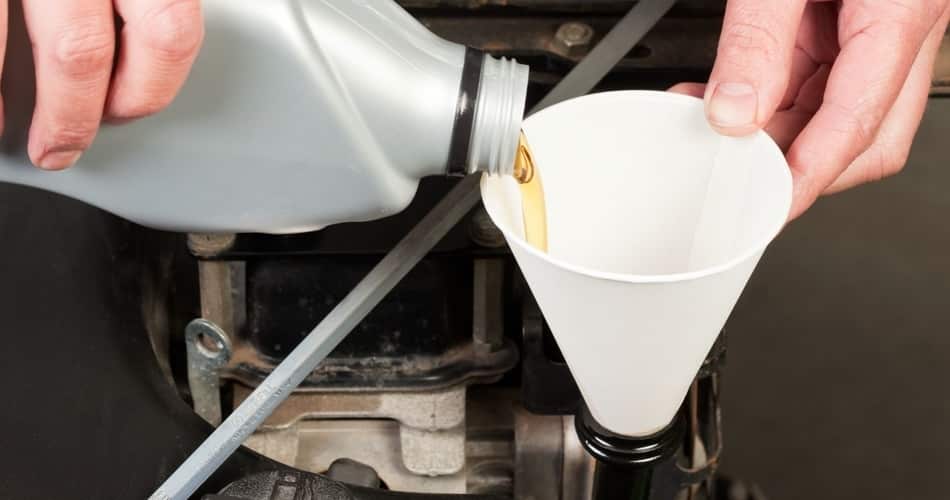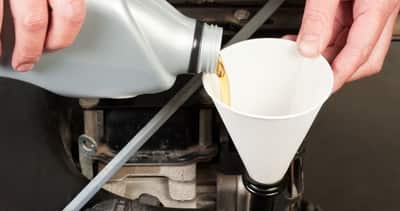You just realized you forgot to change the engine oil in your snowblower. Now you want to know what damage can happen to your engine. I have seen many failed engines in snowblowers due to running dirty oil.
If you don’t change the oil in your snowblower, the oil becomes very dirty and breaks down. The oil loses its detergents which can cause significant damage to your engine.
There are many people who are under the misconception they don’t need to change the engine oil in their snowblower. This is so not the case. The oil in the engine does more than people think.
People often don’t think about putting money into their snowblower until it doesn’t start or encounter other engine problems. Give your snowblower a little bit of attention once a year and you will be surprised how long that snowblower can last you.
This article addresses 4-stage (4-cycle) snowblower engines. Follow the safety precautions listed in your operator’s manual before working on your snowblower including disconnecting the spark plug wires.

This post may include affiliate links. Purchases made through these links may provide a commission for us, at no extra cost to you. As an Amazon Associate, we earn from qualifying purchases.
Follow all safety instructions provided in your equipment operator’s manual prior to diagnosing, repairing, or operating.Consult a professional if you don’t have the skills, or knowledge or are not in the condition to perform the repair safely.
What Does Engine Oil Do in a Snowblower?
The average snowblower small engine only holds about 3/4 to 1 quart of oil. This engine oil is usually a 5W-30 weight oil. That little amount of oil has a lot of work to do in such a small space.
Oil will break down over time. All of the cooling agents and detergents in the oil will eventually disappear or break down. The ingredients in our oils are designed to do a lot of things:
- Acts as a cooling agent that keeps the internal parts of your engine cool while it is building heat from friction
- Acts as a buffer between moving parts. These moving parts build heat in the engine.
- Acts as a cleaner. It keeps carbon and broken down oil from clogging up oil passages in the internal routes of the engine. If these routes get plugged oil cannot get through which can damage the engine.
What Happens When I Don’t Follow Manufacturer’s Oil Change Guidelines?
Most small engine manufacturers say engine oil should be changed every 25 to 50 hours of use. The hourly interval depends on the capacity of the engine and how hard it gets used.
If your engine is new you will want to perform your initial oil change 2 to 10 hours after its first use. Consult your engine manufacturer’s recommendation for this first oil change.
Engine oil is designed to keep the internal components of your engine running smoothly and reduces friction among the moving parts. It’s important to change your oil as oil becomes dirty and degrades over time.
Taking time to change your engine oil regularly will ensure your engine lasts more than a couple of years. The price of a quart of oil is a pretty inexpensive insurance policy if you think about all it does to protect the engine and its components.
Should You Replace the Engine or Replace the Snowblower?
Remember, if you don’t change your engine oil you could end up with the expense of replacing the engine. The engine is the main component of your snowblower.
If it fails, you need to consider a couple of options before making an additional investment in your snowblower.
Should you replace the engine or replace the snowblower? You will want to take the expense of a new engine and the life span of the snowblower into account when deciding to make a significant engine purchase.
An engine can be replaced in a snowblower without too much trouble with the installation. The cost will be the biggest factor you will want to consider before purchasing a new engine.
A replacement snowblower engine will cost anywhere from $300.00 up to $1000.00 depending on manufacturer, horsepower, and crankshaft size. Snowblowers generally range between 6.5 hp and 14 hp.
Replacement engines can be purchased online or from your local engine dealer. Engines can look similar when shopping on the internet, but it may not be the correct engine you need.
Make sure you have your model and spec number to purchase a compatible engine.
You will also need these same numbers if you want to order parts for your engine. If you are unsure whether you are selecting the right engine online, you may want to purchase from an engine dealer.
The knowledgeable staff at the dealership will be able to assist you in finding an engine that will fit.
You should consider, in addition to cost, the condition of your snowblower. Are you going to have to put a lot of money into the frame, shell, or deck of the snowblower anytime soon?
It may be more cost-efficient to purchase a new snowblower rather than put additional investment into an old snowblower.
Why am I Always Adding Engine Oil to My Snowblower Each Time I Use It?
It’s always good to check the level of your engine oil before you mow. If you find yourself always adding oil to your engine before you go out to blow snow that’s not always a drastically bad thing, but it also is not a good thing.
You need to find out why you always have to put oil in your engine. You may be adding oil to your engine each time you use your snowblower because you have an oil leak or your engine is consuming oil. You need to identify which one of these scenarios applies to your engine oil loss.
- Oil Leak – Look over the engine area to find signs of an engine oil leak. Once you find the cause of the leak, replace the gaskets from which the oil is coming. You will also want to inspect your filter if your snowblower uses one. Make sure your oil filter is sealing properly.
- Burning / Using Oil – This can be an indication of a valve or ring problem. You need to take your snowblower to a repair center for an engine diagnosis.
Items Needed for an Engine Oil Change
Selecting the Correct Engine Oil
Make sure you select the correct engine oil before your oil change. Gas-powered snowblower small engines will use 5W-30 engine oil.
Oil Collection Container
Find an item to collect the oil in. A drain pan is best. If you don’t have a drain pan, find a container that has a large enough capacity to hold the used oil and will not leak all over the floor.
Also, make sure you have a closed container for the used oil to take to a recycling center. You can use empty oil containers.
Do not use milk or soda containers. Never dispose of engine oil in the landfill, in your drain, or on your property.
Tools
You will need to get the correct size socket or wrench to remove the oil plug. Some plugs are square while others are hex-plug in varying sizes.
A funnel will make adding new oil a lot easier. You will also need a filter wrench if your engine uses a filter.
Some people choose to use an oil evacuator and extract the oil instead of draining it.
Oil
Most snowblower engines do not use an oil filter because the snowblower is not a frequently used item. It is important to change your engine oil and keep it clean of contaminants. Snowblowers use 5W-30 engine oil.
Other Helpful Supplies
Cardboard or newspaper is useful to keep oil from getting on your work surface. It is also good to have rubber gloves and rags on hand.
Do Not Overfill with Engine Oil
It is necessary to make sure you are running good clean oil through your snowblower’s engine to ensure top performance. Make sure you fill your engine crankcase with oil to the correct fill level as shown on the dipstick.
Overfilling your snowblower’s engine can cause engine problems. We explain in more detail in “Too Much Oil in Your Snowblower Can Cause Engine Damage“.
